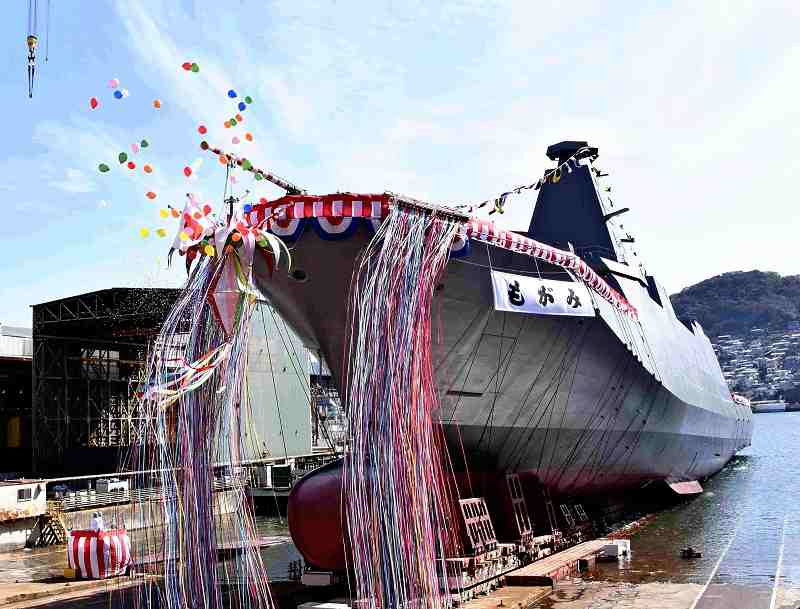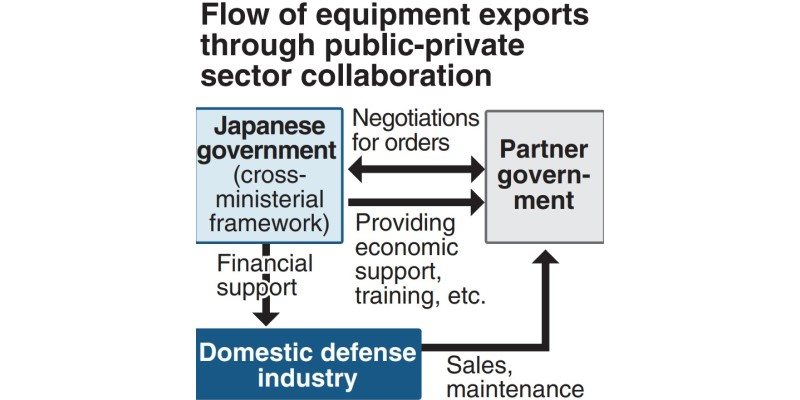Defense Perspective: Proposals / Increase military equipment transfers via public-private collaboration

The new model frigate FFM, which was developed through collaboration by the public and private sectors, is seen on March 2021 in Nagasaki.
2:00 JST, November 24, 2022
The government will by the end of this year revise three key security-related documents — the National Security Strategy, the National Defense Program Guidelines, and the Mid-term Defense Program — aiming to significantly strengthen the nation’s defense capabilities. What must be done before this major change in Japan’s postwar security policy? This is the last installment of a series featuring defense proposals from The Yomiuri Shimbun.
***
As an island nation, Japan would have difficulty receiving support from other countries in the event of a crisis, and must rely on the domestic defense industry to increase production of military equipment. To boost defense capabilities, it is essential to promote the defense industry.
Due to low-profit margins and small order volumes, companies are withdrawing from the industry one after another, and to put the brakes on this situation, the time has come for the government to start providing bold support by increasing subsidies and other means.

The key to transforming the defense industry into a growth industry is to increase equipment exports. Through the transfer of equipment, Japan will not only be able to expand its markets overseas, but deepen defense cooperation with other countries and strengthen ties.
This is also in line with the national policy of “proactive pacifism” to contribute to world peace and stability. Defense Minister Yasukazu Hamada emphasized that “the driving of equipment transfers will create a desirable security environment.”
To win the international competition for orders against countries that have the public and private sectors working in collaboration, Japan also needs to establish a system in which the government leads the negotiations. Japan has had a tough time selling domestic products despite their highly regarded performance, as exemplified in the loss to France in 2016 for an order for Australia’s next-generation submarine program.
Japan had proposed a modified version of its Maritime Self-Defense Force (MSDF) submarine, which was considered the world’s highest class at the time, with superior stealth and navigational performance. However, France won the order by touting the creation of jobs through local production and other aspects.
Australia later changed to a policy of introducing nuclear-powered submarines, with the support of the United States and United Kingdom, following the establishment of a framework for security cooperation with them. This highlighted the reality that the international rivalry for orders is driven by politics. It would be worthwhile to consider the creation of a cross-ministerial framework that allows proposals to be made in line with the needs of partner countries, in combination with economic and other assistance.
The government should also make efforts to bring out the expertise and technological prowess of the defense industry to reinvigorate the domestic market. In this regard, the development of the FFM, a new model of frigate, two of which were commissioned in 2022, is a good example.
Conventionally, the Defense Ministry decided on the detailed specifications and placed the order with companies. But in the case of the FFM, the ministry only presented rough ideas about the vessel, such as having a more compact hull and limiting production costs to about ¥50 billion per ship. In its new procedure, companies were invited to come up with detailed functions and the design for the ship.
Three companies submitted bids, and in the end, the proposal by Mitsubishi Heavy Industries, Ltd. received the highest overall score and was chosen. The result was a new ship with a crew reduced to 90, about half that of a conventional frigate, that has anti-mine warfare capabilities.
The ministry plans to have a total of 22 FFMs built. As the number of surveillance missions by the MSDF increases and it becomes more difficult to secure sufficient crew, the manpower-saving FFM is expected to fill a vital role in maritime defense.
Unless such a cooperative system between the public and private sectors is realized going ahead, a “battle-ready SDF” cannot be maintained, and enhancing deterrence will not be possible.
"Politics" POPULAR ARTICLE
-

Japan to Support Central Asian Logistics Route That Bypasses Russia, Plan to Be Part of Upcoming Summit in Tokyo
-

Japan to Tighten Screening of Foreigners’ Residential Status by Providing Information of Nonpayment of Taxes
-

Chinese, Russian Bombers Flew Unusual Path by Heading Toward Tokyo; Move Likely Meant to Intimidate Japan
-

Japan Plans National Database to Track Foreign Ownership of Real Estate, Land as It Weighs New Rules
-

Up to 199,000 Deaths Estimated From Mega-Tsunami; Most Recent Occurrence Took Place in 17th Century
JN ACCESS RANKING
-

Keidanren Chairman Yoshinobu Tsutsui Visits Kashiwazaki-Kariwa Nuclear Power Plant; Inspects New Emergency Safety System
-

Tokyo Economic Security Forum to Hold Inaugural Meeting Amid Tense Global Environment
-

Imports of Rare Earths from China Facing Delays, May Be Caused by Deterioration of Japan-China Relations
-

University of Tokyo Professor Discusses Japanese Economic Security in Interview Ahead of Forum
-

Japan Pulls out of Vietnam Nuclear Project, Complicating Hanoi’s Power Plans

























